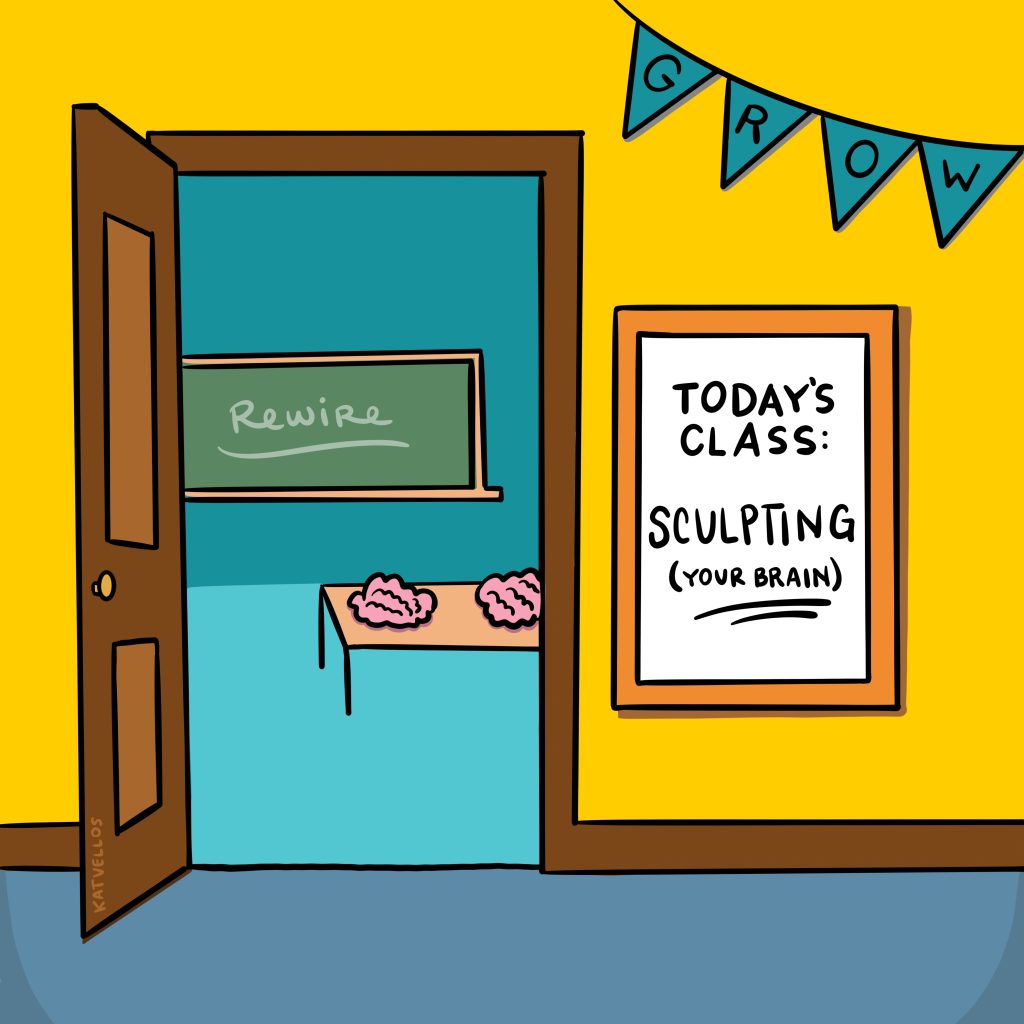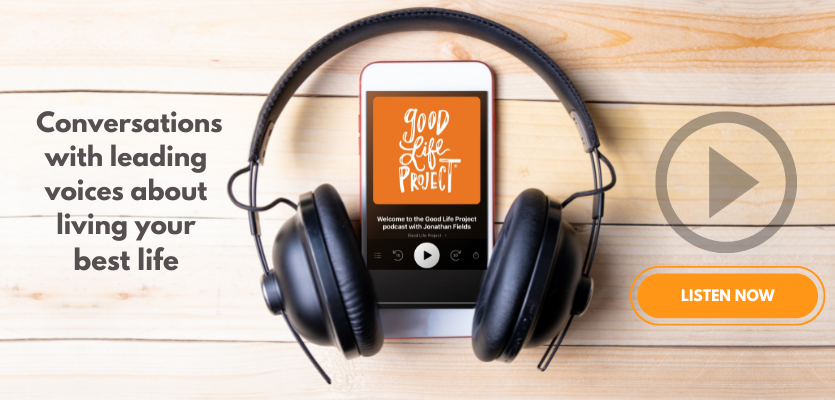Good news: your brain is wired to keep you alive.
Bad news: that same wiring is … kinda bumming you out.
Turns out we all have this particular twist of evolutionary biology that makes negative experiences stick in our brains, while positive ones tend to slide right on through. (If you’re thinking to yourself right about now, “Oh, that’s why I always seem to focus on the one tiny negative comment and ignore positive feedback”, you’re right.)
But here’s a really powerful secret –– you can learn to leverage that same biology to cultivate deep, lasting happiness and encourage your brain to latch onto the positive.
It all comes down to understanding Velcro® Brain vs Teflon™ Brain.
This is a term Dr. Rick Hanson uses for what’s technically called positive-negative asymmetry, or the negativity bias. It shapes your implicit memory (the lens through which you see the world) and it starts early –– as in, from the time you’re three months old.
According to Hanson, when it comes to the negative, our brains are Velcro®. They evolved to latch onto negative experiences and store them nearly-instantaneously. Once your “threat center” finds something to worry about, it instantaneously dominates your attention and transfers that negative experience into the long-term memory part of your brain, sometimes before you’re even aware of what’s going on.
When it comes to the positive, your brain is like Teflon™. It doesn’t register positive experiences as readily, and it takes much longer to imprint them in the long-term memory part of your brain — between 12 and 24+ seconds, depending on whose research you read.
From a “survival of the species” standpoint, this whole setup makes sense, right? Because as we evolved, the people who were best able to notice, respond to, and remember threats were the most likely to survive. It’s the evolutionary equivalent of touching a hot stove when you’re a child. It hurts, but it also teaches you not to do that again. But sometimes that same response backfires, and causes more harm than good.
Your negative thought patterns are survival instincts gone overboard. But you can learn to use it for good.
50,000+ years of evolutionary biology isn’t going anywhere. But you can use your mind to control your brain, literally changing the neural pathways that make up your experience and memories. (This ability is called self-directed neuroplasticity.) Here’s how you do it.
5 ways to stop focusing on the negative and pivot your negativity bias into positivity and possibility:
- Accept your negativity bias. It might seem like the best thing you can do to feel more peace and ease is to shut down the negative reflex. Suppress the source of the negativity, and you’re left with greater positivity, right?Here’s the thing though: in one of those counterintuitive little twists of biology, if you try to suppress your brain’s negativity bias, you’re just going to end up making it more powerful. You have this built-in alarm system for a reason, if you try to ignore it or shut it down, it’s just going to get louder and louder until you finally pay attention.
From Social, Cognitive, and Affective Neuroscience and Biological Psychiatry:
Research comparing the effects of acceptance vs suppression on the amygdala found that “emotion acceptance was associated with significantly decreased early phase amygdala and hippocampal activation relative to worry” while “suppression sustained elevated responses in amygdala and insula … suggesting suppression may be achieved in emotionally challenging situations but at a cost, namely, sustained activation that may be physiologically taxing and lead to disturbances in psychological and physical functioning.”
So give the self-help and personal development techniques based on never, ever, ever thinking about the negative stuff a pass. They’re just aggravating your amygdala.
- Avoid the “second dart”. Hand in hand with accepting that you have a bias is being willing to avoid the “second dart”. This is a metaphor Buddha used to describe that nasty little spiral in which something bad happens (that’s the first dart), and then you start feeling bad about feeling bad, or feeling guilty because you feel guilty, or angry because you can’t seem to control your anger.These are called meta-emotions, by the way, and the way you interact with them affects you on a physical level. In one study from Cognitive Therapy and Research, researchers found that:“Negative meta-emotions were differentially associated in the two groups with the control of heart rate by the two branches of the autonomous nervous system.”Another in Emotion found that these meta-emotions are both common and powerful.Most adults experienced meta-emotions, especially during moments of high attention to emotion, and negative-negative experiences were positively associated with depressive severity.Long story short? If you let those second darts land, they’re just going to reinforce the negativity associated with the first dart.

Art by Kat Vellos
- Practice mindfulness. A simple mindfulness practice can make a huge difference in how your brain categorizes and stores information: research shows that even a brief dip into mindfulness can shift your negativity bias towards the positive. From Social Psychological and Personality Science:“A randomized experiment compared a brief mindfulness induction to an unfocused attention control condition … Participants in the mindfulness condition demonstrated less negativity bias in attitude formation [and] reported higher levels of optimism compared to the control condition. Together, these results suggest that mindfulness increases positive judgments and reduces negativity bias.”See what you can do to be a little more mindful as you go about your days. There are loads of methodologies and courses that can help you with this, but you can start with something as simple as grounding your attention back in the present with a few deep, slow breaths. It really can be that simple.
- Use your body to soothe your brain. We tend to think of the body and brain as being kind of separate beings, but that really couldn’t be further from the truth. Just as your state of mind impacts your body — for instance, you get nervous so you get butterflies in your stomach; or you get angry and your shoulders climb up to your ears — the state of your body impacts your brain.Even a tiny, fake-feeling change, like forcing a smile, signals to your brain that things are good, and raises your mood. If you can figure out a way to make your body feel good, the endorphins it releases as a result will naturally raise your mood. Try exercising:“The link between exercise and mood is pretty strong. Usually within five minutes after moderate exercise you get a mood-enhancement effect.” (APA Monitor on Psychology) Or getting outside:“Proximity to greenspace has been associated with lower levels of stress and reduced symptomology for depression and anxiety…” (Frontiers in Psychology)Or even just taking a few deep breaths:Breathing deeply and intentionally “down-regulates activation in the amygdala and increases its integration with prefrontal regions [aka the part of the brain associated with calm, higher-level functioning.]” (NeuroImage)
HEAL Everything we’ve talked about so far is really good at shifting your mood and working with Velcro brain. Turns out that you can actually work with Teflon brain too! Remember how Teflon brain takes much longer to clock and retain positive experiences?
You can use the HEAL method, as described by Rick Hanson, to turn those “passing mental states [into] lasting neural traits.” The way it works is:
Have a good experience. Activate the positive feeling by having something good happen. You get a good cup of coffee, you have a laugh with a friend, you hug your daughter. You get it.
Enrich the experience. Instead of just letting it happen, really lean into the experience. When you recognize that something good is happening, turn up the volume on it. Amp up the colors in your mind. Be fully present. This “installs” the positive memory in your brain.
Absorb the experience. Take some time to let the experience sink into your body, soak it in physically. This helps your brain encode it into long-term memory more efficiently.
Link the positive and the negative. This is a next-level, bonus thing, but if you’re feeling really positive, then ground down into that good feeling and start to link it to a not-so-good feeling. Let the good feeling sit side by side with the negative one, and acknowledge that you can feel both ways at once. And if you can, gradually let the negative feeling dissolve into the positive one.
From Rick Hanson:
“Neurons that fire together, wire together. Linking the positive with the negative helps you soothe the negative and eventually let it dissolve.”
Let’s recap.
— You’re wired for survival, with your brain being naturally biased toward remembering negative experiences. You can’t get rid of this wiring, but you can learn to work with it to pivot towards happiness.
— Accept your bias: it’s not going anywhere, and fighting it just makes it stronger.
— Avoid the “second dart” (AKA feeling bad about feeling bad). This just reinforces negativity.
— Practice mindfulness: it trains your brain to take in the positive.
— Use your body to soothe your brain: the body/brain relationship goes both ways. Happy body = happy mind.
— HEAL: Have a positive experience, Enrich it, Absorb it, and Link it to the negative.
That’s a lot of info, but the first step is really easy: choose just one of these things to try today. Even the tiniest action can help jumpstart that positive spiral, so make sure you take one.
You’ve got this!




